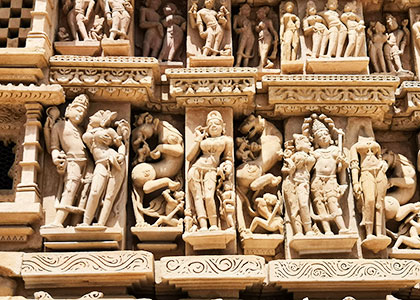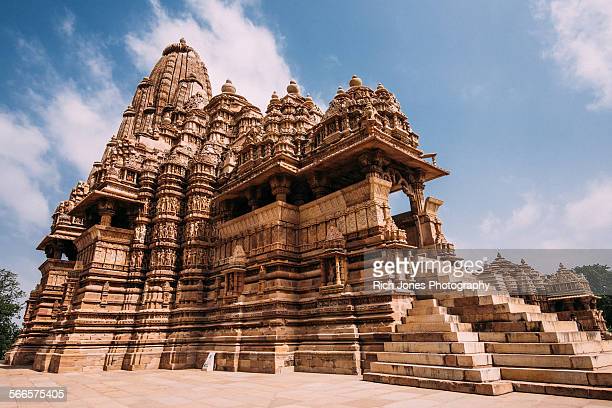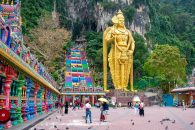
Top Attractions in Khajuraho, India
History
The Khajuraho temples, which are famous for their architecture and Erotic art, were constructed by the Chandela dynasty rulers. The Chandela kings governed a substantial portion of the Bundelkhand region (then known as Jejakabhukti) in central India from the 9th to the 13th centuries.
The Khajuraho temples were actively used for religious purposes until the Delhi Sultanate seized control of central India at the conclusion of the 12th century. Following that, Muslim rule continued in the area until the 18th century, during which period several of the temples were either destroyed or fell into disrepair. This included the demolition drive by Sikander Lodi in the late 15th century. Today, just 20 of the original 85 temples remain, and they were discovered in the 19th century by British surveyor T.S. Burt, with the help of local Hindus.
:max_bytes(150000):strip_icc():format(webp)/GettyImages-860931042-3d6b27e65fe24caab44f291ad6088da1.jpg)
Location
Khajuraho is in northern Madhya Pradesh, approximately 385 miles (620 kilometers) southeast of Delhi. It’s set against the backdrop of the extensive Vindhya mountain range.
How to Get There
Khajuraho is most easily reached by flight, or overnight long-distance train from Delhi via Agra (the 12448/UP Sampark Kranti Express), or Udaipur via Jaipur and Agra (the 19666/Udaipur City Khajuraho Express). Both trains stop at Jhansi.
There are also two daily unreserved local passenger trains from Jhansi to Khajuraho. The best and fastest one is the 51821/Jhansi – Khajuraho Passenger (via Mahoba). It leaves Jhansi at 7:10 a.m. and arrives in Khajuraho at noon, with 18 stops.
The road from Jhansi to Khajuraho has improved. The journey now takes approximately 5 hours, and costs from about 3,500 rupees for a taxi. The bus can be particularly arduous, so hiring a taxi is a better option.

How to Visit the Temples
The temples are open daily from sunrise until sunset. Ideally go during the cooler months from November to March.
Tickets are only required to enter the Western group of temples. The price increased in August 2018. Foreigners are now charged 600 rupees per adult, while Indians pay 40 rupees. Children younger than 15 years are free. Tickets can be purchased online here (select Bhopal as the city and then “Western Group of Monuments”) or at the monuments. They provide admission to the government archeological museum as well.
To get all the risque details of the carvings, you’ll need to hire a tourist guide from near the ticket counter. Expect to pay around 1,600 rupees for half a day, which is quite costly. Unfortunately, audio guides are no longer available.
While the Western group of temples (the main group) is situated near many hotels, the Eastern group is a mile or so away in another village and the Southern group is near the airport. Hiring a bicycle or auto rickshaw are popular ways of traveling between them and there are stalls near the main temple complex. The Eastern and Southern temples are superb at sunset.
Although Khajuraho is a peaceful and laid-back town, being hassled by touts is unavoidable. They’re prevalent and persistent. Ignore anyone who approaches you in the street, especially anyone who wants to take you to their shop or hotel (or offers to sell you anything). Don’t be afraid to be assertive and forceful in responding, otherwise they’ll take advantage of your politeness and not leave you alone. This includes children, who will pester you relentlessly for pens and other items.
:max_bytes(150000):strip_icc():format(webp)/KhajurahoTemples-India-AnnaHaines130-dce216584f184da29545085784730b08.jpg)
What to See
There are three groups of temples—Western, Eastern, and Southern. The main temples are in the Western group, which features the magnificent Kandariya Mahadev and Vishwanath temples. These Nagara-style temples are where you’ll find most of the famous erotic sculptures. The Eastern Group contains a handful of exquisitely carved Jain temples. There are only two temples in the Southern group. They’re not as spectacular but they’re worth seeing. The Dulhadeo temple is dedicated to Shiva’s bridegroom form, while the Chaturbhuj temple has an unusual form of Vishnu as the presiding deity.
A sound and light show, narrated by the Bollywood icon Amitabh Bachchan, is held every evening after sunset at the Western group of temples. Tickets can be purchased an hour or two in advance from the counter there. Shows are in Hindi and English, with tickets for the English show priced much higher. Foreigners may want to skip it, as the 700 rupee ticket price is steep! The Hindi show only costs 250 rupees.
A week-long classical dance festival takes place in Khajuraho each year, in late February. The festival, which has entertained audiences since 1975, showcases classical dance style from all over India. It offers a captivating way of seeing the various classical styles of Indian dance, including Kathak, Bharat Natyam, Odissi, Kuchipudi, Manipuri, and Kathakali. The dances are performed in the Western group of temples, mainly at the Chitragupta Temple (dedicated to Surya the Sun God) and the Vishwanatha Temple (dedicated to Lord Shiva). A large arts and crafts fair also happens during the festival.
Why all the Erotica?
Of course, it’s natural to wonder why the hundreds of erotic sculptures were made. They’re rather explicit, and even portray bestiality and group activities. What’s interesting is that although the Khajuraho temples have the largest number of these sculptures, there are other temples in India (such as the Konark Sun Temple in Odisha) that have similar ones dating back to the 9th-12th centuries.
However, there’s no one generally accepted reason as to why they exist! Some believe it to be auspicious, as there are also carvings of mythical creatures on the temple walls. Others interpret it to be sex education, directed at rekindling passion in the minds of people who may have been influenced by Buddhism at the time. Another explanation is derived from Hinduism, and the need to leave lust and desire outside before entering the temple. Most likely there is an association with the esoteric cult of Tantra. The oldest temple in Khajuraho, the 64 Yogini temple, is a Tantric temple dedicated to 64 goddesses who drink the blood of demons. There are only four temples of this kind in India. Another is located near Bhubaneshwar in Odisha.
What to Do Nearby
Two interesting museums showcase the cultural heritage of the region. The Archeological Museum next to the Western group of temples has rare finds from excavations at Khajuraho such as panels and sculptures from temples. It’s open daily from 10 a.m. to 5 p.m. The Adivart Tribal and Folk Art Museum in the Chandela Cultural Complex displays Dokra figurines, folk paintings, Gond art, terracotta, and masks. It’s open daily, except Mondays, from noon until 8 p.m. Entry is free.
Check out Shilpagram, a craft village run by the Ministry of Culture, for exhibitions, film festivals, craft fairs and folk performances.
Matangeshwar temple, next to Shivsagar Lake at the center of town, is an evocative place for quiet contemplation.
To experience village life, take a stroll around the tiny neighboring hamlets of Jawari and Jatkara. The locals are friendly and the building walls beautifully painted.
:max_bytes(150000):strip_icc():format(webp)/GettyImages-529387640-5f66002f10854bfbbcc3366c1098f6dd.jpg)
Off-the-beaten-track in the Panna district of Madhya Pradesh (about an hour from Khajuraho) are crumbling remains of 9th century Ajaigarh Fort. Not many people know about this fort, and it’s relatively deserted. Do note that you’ll need to do quite a bit of climbing and it’s worth taking a guide.
Only half an hour away is the added attraction of the dense, wildlife-filled jungle of Panna National Park. Or, head to little-known Ken Gharia Sanctuary adjoining it to see a volcanic crater. A boat trip along the Ken River, which flows through the forest, is a highlight.









I like this place